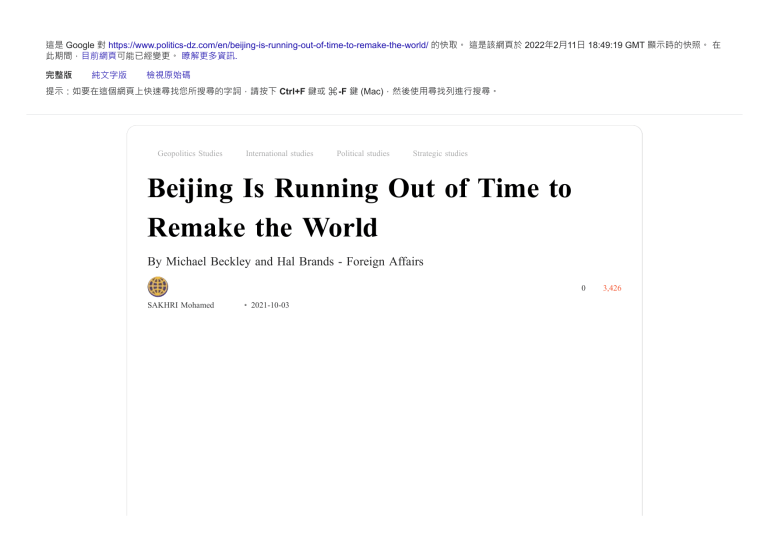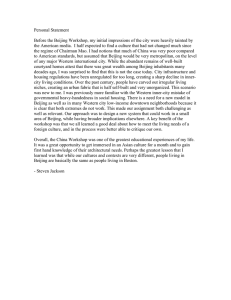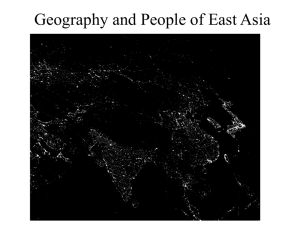
這是 Google 對 https://www.politics-dz.com/en/beijing-is-running-out-of-time-to-remake-the-world/ 的快取。 這是該網頁於 2022年2月11日 18:49:19 GMT 顯示時的快照。 在
此期間,目前網頁可能已經變更。 瞭解更多資訊.
完整版
純文字版
檢視原始碼
提示:如要在這個網頁上快速尋找您所搜尋的字詞,請按下 Ctrl+F 鍵或 ⌘-F 鍵 (Mac),然後使用尋找列進行搜尋。
Geopolitics Studies
International studies
Political studies
Strategic studies
Beijing Is Running Out of Time to
Remake the World
By Michael Beckley and Hal Brands - Foreign Affairs
0
SAKHRI Mohamed
• 2021-10-03
3,426
The prevailing consensus, in Washington and overseas, is that China is surging past the United
States. “If we don’t get moving,” President Joe Biden has said, “they’re going to eat our lunch.”
Countries everywhere are preparing, in the words of an Asian diplomat, for China to be “number
one.”
Plenty of evidence supports this view. China’s GDP has risen 40-fold since 1978. China boasts the
world’s largest financial reserves, trade surplus, economy measured by purchasing power parity,
and navy measured by number of ships. While the United States reels from a shambolic exit from
Afghanistan, China is moving aggressively to forge a Sinocentric Asia and replace Washington
atop the global hierarchy.
But if Beijing looks to be in a hurry, that’s because its rise is almost over. China’s multidecade
ascent was aided by strong tailwinds that have now become headwinds. China’s government is
concealing a serious economic slowdown and sliding back into brittle totalitarianism. The country
is suffering severe resource scarcity and faces the worst peacetime demographic collapse in
history. Not least, China is losing access to the welcoming world that enabled its advance.
Welcome to the age of “peak China.” Beijing is a strong revisionist power that wants to remake
the world, but its time to do so is already running out. This realization should not inspire
complacency in Washington—just the opposite. Once-rising powers frequently become aggressive
when their fortunes fade and their enemies multiply. China is tracing an arc that often ends in
tragedy: a dizzying rise followed by the specter of a hard fall.
Related Articles
Modi’s Foreign-Policy Juggling
The Geopolitics of Video Games
Act
2021-12-28
5 days ago
China Reckons With Omicron’s
Regional coal power over
Specter
capacity assessment in China
2021-12-28
from 2020 to 2025
2021-12-24
MAKING A MIRACLE
China has been rising for so long that many observers think its ascendance is inevitable. In fact,
the past few decades of peace and prosperity are a historical anomaly, caused by several fleeting
trends.
To start, China enjoyed a mostly safe geopolitical environment and friendly relations with the
United States. For most of its modern history, China’s vulnerable location at the hinge of Eurasia
and the Pacific had condemned it to conflict and hardship. From the First Opium War in 1839 until
the end of the Chinese Civil War in 1949, imperialist powers ripped apart the country. After China
unified under communist rule in 1949, it faced extreme U.S. hostility; Beijing suffered the enmity
of both superpowers after the Sino-Soviet alliance collapsed in the 1960s. Isolated and
surrounded, China was racked by poverty and strife.
The opening to the United States in 1971 broke this pattern. Beijing suddenly had a superpower
ally. Washington warned Moscow not to attack China and fast-tracked Beijing’s integration with
the wider world. By the mid-1970s, China had a safe homeland and access to foreign markets
and capital—and the timing was perfect. World trade surged sixfold from 1970 to 2007. China
rode the momentum of globalization and became the workshop of the world.
If Beijing looks to be in a hurry, that’s because its rise is almost over.
It could do so because China’s government was largely committed to reform. After Mao Zedong’s
death in 1976, the Chinese Communist Party (CCP) instituted term limits and other checks on its
top leaders. It began to reward technocratic competence and good economic performance. Rural
communities were allowed to set up loosely regulated enterprises. Special economic zones
expanded across the country and allowed foreign businesses to operate freely. In preparation for
joining the World Trade Organization in 2001, Beijing adopted modern legal and tax collection
systems. China had the right package of policies to thrive in an open world.
China also had the right kind of population. It experienced the greatest demographic dividend in
modern history. In the first decade of this century, it boasted ten working-age adults for every
senior citizen. The average is closer to five for most major economies.
That demographic advantage was the fortuitous result of wild policy fluctuations. In the 1950s
and 1960s, the CCP encouraged women to have many children to boost a population decimated
by warfare and famine. The population surged 80 percent in 30 years. But in the late 1970s,
Beijing pumped the brakes, limiting each family to one child. As a result, in the 1990s and in the
early years of this century, China had a massive workforce with relatively few seniors or children
to care for. No population has ever been better poised for productivity.
China did not need much outside help to supply its citizens with food and water and its industries
with most raw materials. Easy access to these resources, plus cheap labor and weak
environmental protections, made it an industrial powerhouse.
REVERSAL OF FORTUNES
But once-in-an-epoch bonanzas don’t last forever. For the past decade, advantages that once
helped the country soar have become liabilities dragging it down.
For starters, China is running out of resources. Half of its rivers have disappeared, and pollution
has left 60 percent of its groundwater—by the government’s own admission—“unfit for human
contact.” Breakneck development has made it the world’s largest net energy importer. Food
security is deteriorating: China has destroyed 40 percent of its farmland through overuse and
become the world’s largest importer of agricultural products. Partly owing to resource scarcity,
growth is becoming very expensive: China must invest three times as much capital to generate
growth as it did in the early years of this century, an increase far greater than one might expect
as any economy matures.
China is also running out of people, thanks to the legacy of the one-child policy. Between 2020
and 2035, China will lose roughly 70 million working-age adults and gain 130 million senior
citizens. That’s a France-sized population of consumers, taxpayers, and workers gone—and a
Japan-sized population of pensioners added—in 15 years. From 2035 to 2050, China will lose an
additional 105 million workers and gain another 64 million seniors. The economic consequences
will be dire. Current projections suggest that age-related spending must triple by 2050, from ten
percent to 30 percent of GDP. For perspective, all of China’s government spending currently totals
about 30 percent of GDP.
Dealing with these problems will be especially difficult because China is now ruled by a dictator
who consistently sacrifices economic efficiency for political power. Private firms generate most of
the country’s wealth, yet under President Xi Jinping, private firms are starved of capital. Instead,
inefficient state-owned enterprises receive 80 percent of government loans and subsidies. China’s
boom was spearheaded by local entrepreneurs, but Xi’s anticorruption campaign has scared local
leaders from engaging in economic experimentation. His government has essentially outlawed
negative economic news, making smart reforms nearly impossible, while a wave of politically
driven regulations has squelched innovation.
As China has become more assertive and authoritarian, the world has become less conducive to
Chinese growth. Beijing has faced thousands of new trade barriers since the 2008 financial crisis.
Most of the world’s largest economies are walling off their telecommunications networks from
Chinese influence. Australia, India, Japan, and other countries are looking to cut China out of
their supply chains.
ECONOMIC QUAGMIRE
With the end of its four-decade holiday from history, China now faces two trends—slowing growth
and strategic encirclement—that spell the end of its rise.
Owing to its accumulating problems, the Chinese economy has entered the most protracted
slowdown of the post-Mao era. China’s official GDP growth rate dropped from 15 percent in 2007
to six percent in 2019, before COVID-19 dragged growth down to a little over two percent in
2020. Even those figures are overstated: rigorous studies show that China’s actual growth rate
could be as low as half the government-listed figure.
Worse still, most of China’s GDP growth since 2008 has resulted from the government’s forcefeeding capital through the economy. Subtract stimulus spending and China’s economy is hardly
growing at all. Productivity, the key ingredient for wealth creation, declined ten percent between
2010 and 2019—the worst drop-off in a great power since the Soviet Union in the 1980s.
For the past decade, advantages that once helped China soar have become
liabilities dragging it down.
The indications of this unproductive growth are ubiquitous. China has more than 50 ghost cities—
urban centers with highways and houses but not people. Almost two-thirds of China’s
infrastructure projects will never recoup the costs of their construction. The result, unsurprisingly,
is out-of-control debt. China’s total debt jumped eightfold between 2008 and 2019. We know how
this story ends: with investment-led bubbles that collapse into prolonged slumps. In Japan,
excessive lending resulted in three lost decades of negligible growth. In the United States, it
caused the Great Recession. Given the size of China’s debt mountain, its downturn could be even
worse. The problems that the massively indebted Chinese property developer Evergrande is now
experiencing may simply be signs of things to come.
The party isn’t admitting defeat: Xi hopes to renew rapid growth through technological
innovation, and R & D spending has tripled since 2006. Yet these efforts have failed to boost
productivity, and China still accounts for small shares of global markets in most high-tech
industries. The main reason is that China’s top-down R & D system, although excellent at
mobilizing resources, stifles the open flow of information and capital necessary for sustained
innovation. The ongoing political clampdown, by incentivizing intellectual conformity, will
compound the problem.
Beijing has, for example, spent tens of billions of dollars on a domestic microchip industry yet still
relies on imports for 80 percent of the country’s computing needs. China threw tens of billions of
dollars into biotech, yet its COVID-19 vaccines can’t compete with those produced in democratic
countries. Innovation won’t save China from slowing growth. And that slump will shake the
system as another threat—strategic encirclement—closes in.
RING OF FIRE
Eurasia has often been a deathtrap for aspiring hegemons: there are too many nearby enemies
that can make common cause with offshore superpowers. For almost 40 years, a rising China
avoided strategic encirclement by downplaying its global ambitions and maintaining friendly
relations with the United States. But that period is over. As Beijing has become more aggressive
in the South China Sea, the Taiwan Strait, and elsewhere, it has engendered hostility nearly all
around.
Over the past five years, the United States has abandoned engagement and embraced neocontainment. Washington has carried out its largest naval and missile expansion in a generation,
imposed its most aggressive tariffs since World War II, and implemented its tightest restrictions
on foreign investment since the Cold War—all directed at China. Arms sales and military support
to frontline states have increased; U.S. technological sanctions are threatening to destroy Huawei
and other Chinese firms. In 2021, China’s deputy foreign minister complained that “a whole-ofgovernment and whole-of-society campaign is being waged to bring China down.”
Xi Jinping will wonder whether he can deliver on his grandiose pledges. And that’s
when the world should get really worried.
The United States’ turn against China has contributed to a broader backlash against Beijing’s
power. In Northeast Asia, Taiwan has become more determined than ever to maintain its de facto
independence, and the government has approved a bold new defense strategy that could make
the island extremely hard to conquer. Japan has agreed to cooperate closely with the United
States to fend off Chinese aggression in the region. Through its own belligerence, Beijing has
given the U.S.-Japanese alliance an explicitly anti-China cast.
The countries around the South China Sea are also starting to hedge against China. Vietnam is
acquiring mobile shore-based missiles, Russian attack submarines, new fighter aircraft, and
surface ships armed with advanced cruise missiles. Singapore has quietly become a significant
U.S. military partner. Indonesia increased its defense spending 20 percent in 2020 and another 21
percent in 2021. Even the Philippines, which courted China for most of President Rodrigo
Duterte’s term, is now reiterating its claims in the South China Sea and ramping up air and naval
patrols.
China’s ambitions are provoking a response beyond East Asia, too, from Australia to India to
Europe. Everywhere Beijing is pushing, a growing cast of rivals is pushing back. The Quadrilateral
Security Dialogue—a strategic partnership that includes Australia, India, Japan, and the United
States—has emerged as a focal point of anti-China cooperation among the most powerful
democracies in the Indo-Pacific. The new AUKUS (Australia–United Kingdom–United States)
alliance unites the core of the Anglosphere against Beijing. The United States is forging
overlapping mini-coalitions to ensure that advanced democracies stay ahead in key technologies,
while the G-7 and NATO are staking out tougher positions on Taiwan and other issues. To be
sure, counter-China cooperation remains a work in progress, because many countries still rely on
trade with Beijing. But these interlocking partnerships could eventually form a noose around
Beijing’s neck.
FLAMING OUT
China is a risen power, not a rising one: it has acquired formidable geopolitical capabilities, but its
best days are behind it. That distinction matters, because China has staked out vaulting ambitions
and now may not be able to achieve them without drastic action. The CCP aims to reclaim
Taiwan, dominate the western Pacific, and spread its influence around the globe. Xi has declared
that China seeks a “future where we will win the initiative and have the dominant position.” Yet
that dream is starting to slip away, as growth slows and China faces an increasingly hostile world.
That may seem like good news for Washington: the chances of China effortlessly sprinting past
the United States are low. But it’s not entirely reassuring. As China’s problems take hold, the
future will look menacing for Beijing. The specter of stagnation will haunt CCP officials. Xi Jinping
will wonder whether he can deliver on his grandiose pledges. And that’s when the world should
get really worried.
China’s leaders are determined to move fast because they are running out of time.
Revisionist powers tend to become most dangerous when the gap between their ambitions and
their capabilities starts to look unmanageable. When a dissatisfied power’s strategic window
begins to close, even a low-probability lunge for victory may seem better than a humiliating
descent. When authoritarian leaders worry that geopolitical decline will destroy their political
legitimacy, desperation often follows. For example, Germany waged World War I to prevent its
hegemonic aspirations from being crushed by a British-Russian-French entente; Japan started
World War II in Asia to prevent the United States from choking off its empire.
China today checks many worrying boxes. Slowing growth? Check. Strategically encircled? Check.
Brutal authoritarian regime with few sources of organic legitimacy? Check. Historical axe to grind
and revanchist ambitions? Check and check. In fact, China is already engaging in the practices—
the relentless military buildup, the search for spheres of influence in Asia and beyond, the effort
to control critical technologies and resources—to be expected from a country in its position. If
there is a formula for aggression by a peaking power, China exhibits the key elements.
Many observers believe China is throwing its weight around today because it is so confident in its
continued ascent. Xi certainly appears to think that COVID-19 and political instability in the United
States have created new possibilities to advance. But the more likely—and much scarier—
possibility is that China’s leaders are determined to move fast because they are running out of
time. What happens when a country that wants to reorder the world concludes it might not be
able to do so peacefully? Both history and China’s current behavior suggest the answer is:
Nothing good.
MICHAEL BECKLEY is Associate Professor of Political Science at Tufts University and Jeane Kirkpatrick
Visiting Fellow at the American Enterprise Institute.
HAL BRANDS is Henry A. Kissinger Distinguished Professor of Global Affairs at the Johns Hopkins
University School of Advanced International Studies and a Senior Fellow at the American Enterprise Institute.
5/5 - (1 vote)
(Read more) The Temper of Communism





